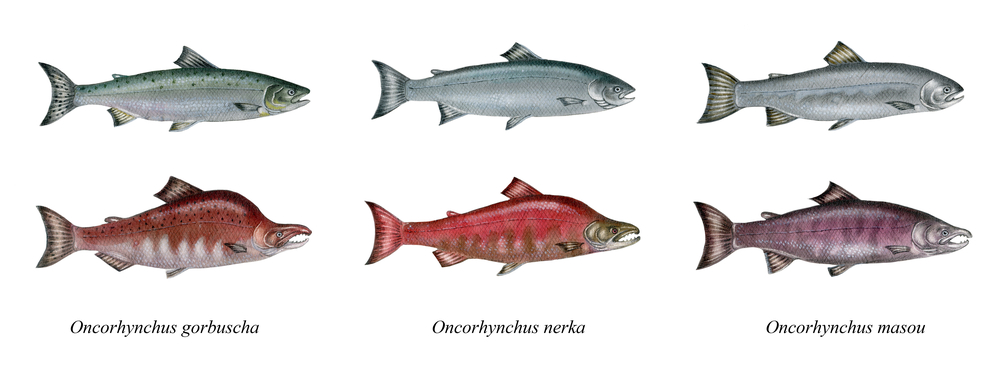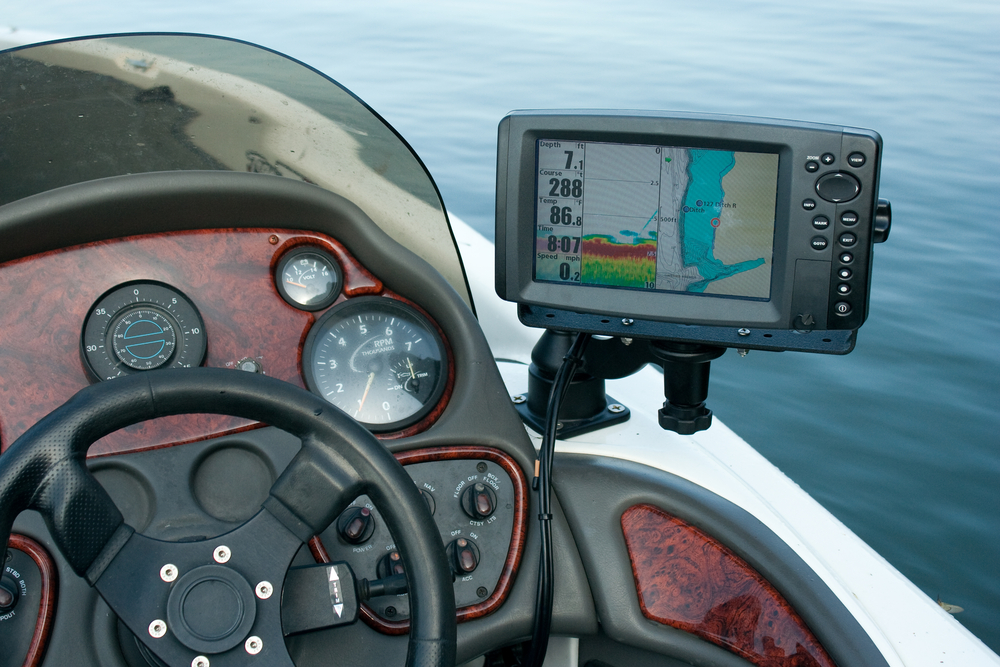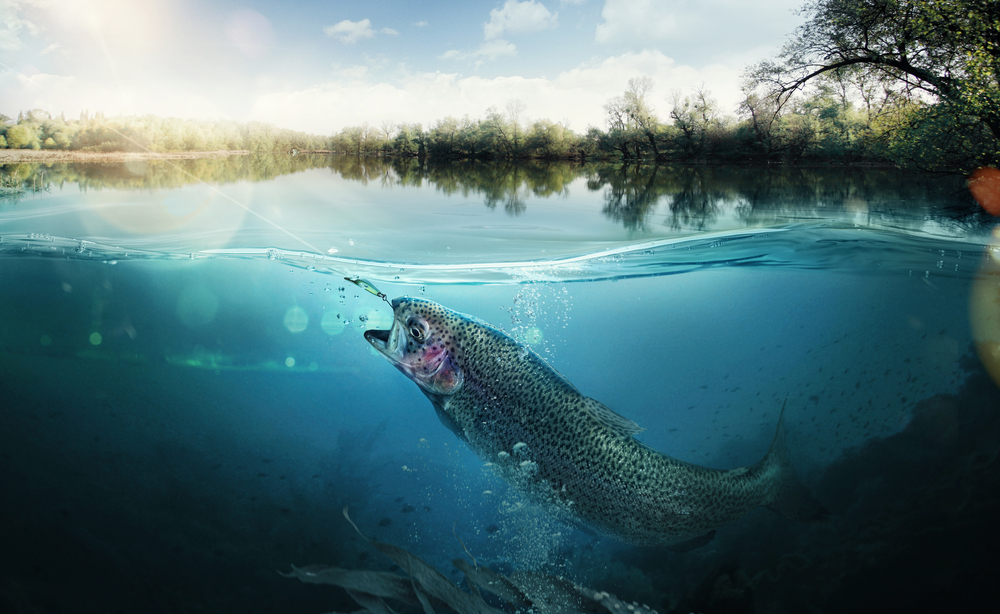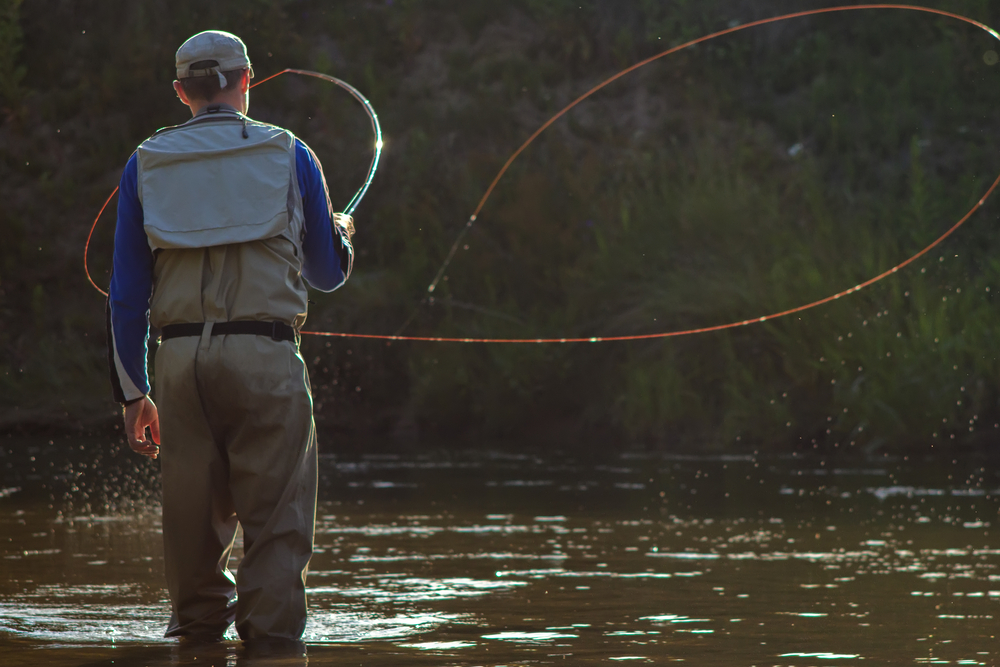What is a salmon
Below is an illustration of different pacific salmon species.

Salmon is the common name for the several species in the family Salmonidae, which also include trout. Salmon are an important commercial and recreational fish that is famous for swimming upriver from the saltwater to breed in freshwater. Most of the ocean’s salmon are located in the Pacific, with the exception of the Atlantic salmon. They have also been successfully stocked in many large lakes in North America, including the Great Lakes.
Salmon Species
Select a species from the list below for detailed information on common types of salmon:
- Atlantic Salmon
- Chinook Salmon
- Chum Salmon
- Coho Salmon
- Pink Salmon
- Sockeye Salmon
5 Tips and Tricks to Catching More Salmon
Downrigging for Salmon doesn’t have to be like solving a Rubik’s cube. Keeping it simple can put fish in the boat; however, becoming a good Salmon angler on the Great Lakes takes time, experience, and attention to detail. Fishing pro Jack Bollinger discusses 5 basic things you should know about to help make you put more salmon in the boat. Jacke is a passionate salmon and steelhead angler, filled with knowledge of fishing the Great Lakes. He shares his expertise and experiences in his blogs in callwild’s fishing category, highlighting his countless hours spent fishing for salmon, as well as providing product reviews and tips. He has played a major role with the Credit River Anglers Association, an organization dedicated to improving the fishery in the Credit River Basin.
Electronics
How important are electronics on the boat? In my opinion, they are essential. GPS and fish finders are a must. Let’s go over the benefits of each.
A GPS system will allow you to do two things:
- Mark your position when you go over a highly concentrated area of bait or fish.
- Allow you to use a Navionics chip.

When trolling over an area where you have hooked a few fish or gone through a big ball of bait, many anglers hit the “mark” button on their GPS system immediately. Trying to find the same spot could be next to impossible but by using the GPS to your advantage, you can never lose track of your “hot spot”.
Secondly, the Navionics chip is crucial when determining structure and staying on a particular contour line. Most new model GPS/fish finders come equip with the capability.
You basically plug it in and the hydrographic chart comes up giving you an underwater lay of the land.
Jack Bollinger
The Great Lakes chip has everything you need for Great Lakes downrigging.
Fish finders are even more essential on the water as you need to find depth first and foremost, as well as marking schools of bait and streaking fish. Remember to set the sensitivity up high on the finder; traveling at speeds of 2-3mph requires a higher than normal signal speed to mark fish and bait.
If you can’t afford a GPS or you are just an oldschool angler, you can always go with the proven solution of the local fishing maps.
Cheating
One way to add a second lure to your line is by clipping a cheater line to your main. This is completely legal; in fact most anglers do this until they find a pattern.
Take 6 feet of quality fluorocarbon leader material. Tie a quality snap swivel to each end of the piece of fluorocarbon. Use a Palomar knot for each snap swivel. This is your cheater line.
Your main line of your downrigger rod is attached to a release clip at the downrigger ball. Drop the downrigger ball to the preferred depth, and you’re half way there. Take the snap swivel of the cheater line that is not connected to the lure and clip it to main line right at the tip of the rod. Throw the lure in the water and it will slide down to the cusp of the bow in the line, approx. half way to about 5 feet above the downrigger ball. This will allow you to fish different depths on one line.
Trolling Speeds
These vary from time of year to current speeds. I won’t get into temp/speed probes at the downrigger ball but generally you should be trolling between 2-3 mph. Slower in the spring due to cold water and faster as the summer and fall approaches. I’ve found that mature chinook salmon like the 2.4-2.8 range. Once you start trolling faster, you will notice that the species of fish that you’re hooking now will be coho salmon and rainbow trout. These species prefer the bait to be moving a little faster.
You also want to pay attention to your rods when turning while you’re trolling. If an inside rod fires, the fish might be telling you they want it slower. If an outside rod fires, then it’s the opposite. Attention to these details may be the difference in putting 5 fish in the boat and 10.
Popular Baits/Lures
Having an arsenal of baits on your boat is the key to success. Sometimes fish want spoons one day and flasher/fly the next. Plug-style baits are very productive: use size 3-4 in the spring and summer, and for the staging fish, use size 5 and troll slowly. These baits can be very successful. spoons are a favorite for many salmon anglers, either with aid of a downrigger or lead core line.

Flasher and fly or meat rigs can be a bit more complex to use but are well worth the investment. Pick yourself up a good selection of styles and sizes. Run the fly about 18-22” behind the flasher for the most part. For meat rigs, try herring strips or whole alewife to run with either a fly, with a teaser head, or even all on its own. Run the whole alewife or herring strip about 4-5 feet behind the flasher. All leader material should be a bit heavier, in the 40lb test area.
A quick note on colors: greens, blues, oranges, blacks, and purples are great colors for the Great Lakes, especially in Lake Ontario.
Fishing Line (Brand and Strength)
Here’s what I run on my rods. I have 2 dipsy rods loaded with 40lb braided line. Braid is good for its low stretch and resistance to abrasions. It also allows the dipsy to go deeper with less line out, another nice advantage. On my downrigger rods I run 20lb line.
At the beginning of the season, I usually pre-tie all of my leaders. I have my slider leaders which are 20lb test and 6 feet long. I have my dipsy leads for spoons in 20 lb test and are anywhere between 6-8 feet long. And lastly, my flasher leaders, which I run behind my dipsys to the flashers, are 40lb test and 8 feet long.
These tips will definitely make you a better angler out on the Great Lakes. The best advice I could give anyone is don’t be hung up on one set up, because every day is different. Run a variety of baits and let the fish tell you what they want. Once you have a pattern going, just duplicate it.
SALMON FISHING TIPS
Jeff shares some of the lessons he learned on the water this summer, including the importance of listening to local tackle shop workers.
I would like to share about one of my favorite fish to target and eat. The Kokanee Salmon is a landlocked form of Sockeye Salmon. In Colorado we have them in several bodies of water including but not limited to: Blue Mesa Reservoir, Gross Reservoir, Antero Reservoir, Green Mountain Reservoir, Carter Lake, Dillon Reservoir, Eleven Mile Reservoir, Granby Lake, Grand Lake,The Greatest Form of Fishing
Herbert Hoover once noted that “All men are equal before fish,” no where is this more true than on a riverbank.
Fly Fishing For Salmon
Fly fishing is not a recent attraction, especially on the West Coast. BC salmon fishing can be done this way, for instance, as well as many other places for salmon fishing in Canada. Experts make this type of salmon fishing look easy, however it does require quite a bit of time and effort to get truly skilled at this style. During the fall, and other times depending on the species and area, many salmon return to their home rivers to spawn. This means that there is always an opportunity to catch salmon from shore, but check with local regulations to make sure that a fishing trip is planned at the right time in accordance with the local laws.
The wet fly swing is the best method when fly fishing on a body of water that is too deep for wading and too far to cast across.
This method consists of casting the fly at a downstream angle and then just letting the fly swing across the current.
Jack Bollinger
This, accompanied with sink tip lines and heavy flies, allows the angler to get the fly down to the bottom where the fish are and it is generally going to give the best results, as well. There are fewer fly patterns for salmon than for other types of fish and traditional patterns are most effective. Reading the water is an essential skill to master for success in fly fishing. The better an angler can read the water, discerning where the fish are, the more fish they will catch as a result of their knowledge.

The two general categories for sink tips are as follows:
One category is named for the number of inches per second in which the line drops through the water. For example, a Type 3 would drop through the water at a rate of 3 inches per second. Then there are the second – longer, heavier tips that are classified by their weight per foot.
Remember that the main goal in fly fishing is to show the fish the fly, and it is better done broadside to the current for the best possible results.
In the end, good results for salmon fishing are easy to obtain if the study hours are put in. Nothing beats practice or the help of qualified salmon fishing guides, but effort is still the primary component in any salmon fishing endeavor. The passion that anglers have for this particular style of fishing is exactly what has kept it so popular all these years and it is no wonder that it continues to be one of the top forms of fishing in the world for both amateur and pro anglers who want to catch a big fish.






